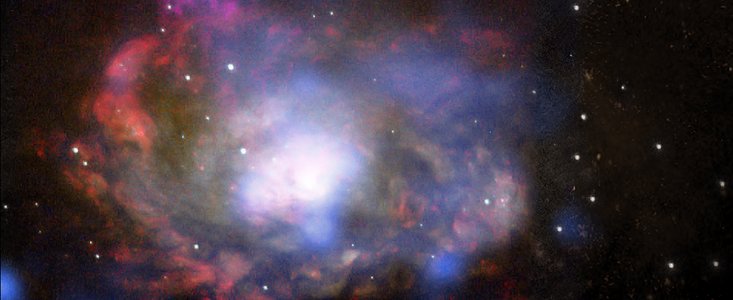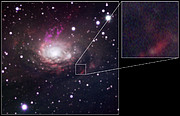Tisková zpráva
Neviditelná sestřenka supernovy SN1987A
Síť dalekohledů zachytila mohutný výbuch blízké supernovy
25. září 2008
Takřka desetiletí po svém výbuchu byla identifikována nejbližší supernova za posledních 25 let. Takový výsledek poskytla kombinace dat z online archivů mnoha největších teleskopů světa.
V roce 2001 byla supernova s označením SN 1996cr zkoumána Franzem Bauerem, který za použití rentgenového dalekohledu CHANDRA americké NASA zaznamenal jasný proměnný zdroj ve spirální galaxii „Circinus“ (galaxie v souhvězdí Kružítka). Přestože zdroj vykazoval neobvyklé vlastnosti, Bauer a jeho tým nebyli v té době schopni určit jeho pravou povahu. Ve skutečnosti trvalo několik let, než byli Baer a jeho tým schopni potvrdit, že je tento záhadný objekt opravdu supernovou. První stopou, která tým přivedla k takřka detektivní práci při prohledávání archivů z 18 různých pozemních i kosmických teleskopů, bylo spektrum pořízené pomocí dalekohledu VLT/ESO. Jelikož se objekt nacházel v zajímavé nepříliš vzdálené galaxii, obsahovaly veřejně přístupné archivy velké množství snímků.
Bylo zřejmé, že SN 1996cr patří k nejjasnějším supernovám, které byli dosud pozorovány v rentgenové a rádiové oblasti záření. To přináší mnoho překvapivých podobností se slavnou supernovou SN1987A, která se objevila v sousední galaxii (ve Velkém Magelanově mračnu), pouhých 160 000 světelných let od Země. „Naše supernova SN1996cr vypadá skoro jako divoká sestřenka SN1987A“, říká Bauer. „Ty dvě jsou si podobné v mnoha ohledech až na to, že novější z nich je ve skutečnosti tisíckrát jasnější v rentgenovém a radiovém oboru“.
Snímky objektu ve viditelné oblasti spektra pořízené Anglo-Australským dalekohledem v Austrálii ukázaly, že SN1996cr explodovala někdy mezi 28. únorem 1995 a 15. březnem 1996. Je tak jedinou z pěti nejbližších supernov za posledních 25 let, která nebyla pozorována již krátce po explozi. Velké rentgenové observatoře na oběžné dráze jako ROSAT či ASCA supernovu SN1996cr nedetekovaly, ale od roku 2001, kdy byla poprvé zaznamenána observatoří CHANDRA, stále zjasňovala. Jediným známým případem supernovy, která v rentgenovém oboru po explozi soustavně zjasňovala, byla do té doby SN 1987A.
„Nalézt SN1996cr způsobem, kterým se to povedlo nám, je spíše otázka štěstěny a bez pomoci pozorování všech použitých dalekohledů bychom to nikdy nedokázali. Prakticky jsme vstoupili do nového věku 'internetové astronomie',“ říká Bauer.
Kombinace dat s teorií umožnila vyvinout model exploze. Předtím, než mateřská hvězda explodovala, vyčistila (v důsledku silného hvězdného větru či outburstu - aktivity v závěrečné fázi života) rozsáhlý okolní prostor od plynu. Rázová vlna samotné exploze se tak mohla bez zábran šířit do prázdného prostoru. Jakmile však zasáhla oblast s vyšší hustotou plynu obklopující SN1996cr, systém se znenadání rozzářil v rentgenovém i rádiovém oboru. Emise vzniklé v důsledku 1987A byly slabší patrně proto, že okolní plyn byl mnohem řidší. Astronomové si myslí, že obě supernovy SN1987A a SN1996cr vykazují známky čištění okolního prostoru kolem hvězdy před její explozí. Z těchto dvou pozorovaných případů lze usuzovat, že tento typ aktivity je v závěrečné fázi vývoje hmotné hvězdy poměrně běžný. „Naše práce naznačuje nejen že SN1987A není zdaleka tak neobvyklá, jak se dříve myslelo, ale říká nám také mnoho o tom, jaké procesy doprovázejí životní cyklus mohutných hvězd,“ říká spoluautor práce Vikram Dwarkadas z Chicagské university.
Poznámky
Výsledky výzkumu byly zveřejněny v časopise The Astrophysical Journal (F.E. Bauer a kol., Supernova 1996cr: SN 1987A's Wild Cousin?, http://arxiv.org/abs/0804.3597)
Galaxie v souhvězdí Kružítka (Cir) je zajímavým objektem s prstenci vyvrženého plynu. Nachází se ve vzdálenosti 13 milionů světelných let.
Kontakty
Franz Bauer
Columbia University
Columbia, Columbia
Tel.: +1 718-637-3071 I117
Email: feb@astro.columbia.edu
Henri Boffin
ESO
Garching, Germany
Tel.: +49 89 3200 6222
Email: hboffin@eso.org
Valentina Rodriguez
ESO
Chile
Tel.: +56 2 463 3123
Email: vrodrigu@eso.org
Anežka Srbljanović (press contact Česko)
ESO Science Outreach Network
a Astronomical Institute of Czech Academy of Sciences
Tel.: +420 323 620 116
Email: eson-czech@eso.org
O zprávě
| Tiskové zpráva č.: | eso0832cs |
| Legacy ID: | PR 32/08 |
| Jméno: | Circinus Galaxy, SN 1996cr |
| Typ: | Local Universe : Star : Evolutionary Stage : Supernova Local Universe : Galaxy : Type : Spiral |
| Facility: | Chandra X-ray Observatory, Hubble Space Telescope, Very Large Telescope |
| Instruments: | FORS1 |
| Science data: | 2008ApJ...688.1210B |
Our use of Cookies
We use cookies that are essential for accessing our websites and using our services. We also use cookies to analyse, measure and improve our websites’ performance, to enable content sharing via social media and to display media content hosted on third-party platforms.
ESO Cookies Policy
The European Organisation for Astronomical Research in the Southern Hemisphere (ESO) is the pre-eminent intergovernmental science and technology organisation in astronomy. It carries out an ambitious programme focused on the design, construction and operation of powerful ground-based observing facilities for astronomy.
This Cookies Policy is intended to provide clarity by outlining the cookies used on the ESO public websites, their functions, the options you have for controlling them, and the ways you can contact us for additional details.
What are cookies?
Cookies are small pieces of data stored on your device by websites you visit. They serve various purposes, such as remembering login credentials and preferences and enhance your browsing experience.
Categories of cookies we use
Essential cookies (always active): These cookies are strictly necessary for the proper functioning of our website. Without these cookies, the website cannot operate correctly, and certain services, such as logging in or accessing secure areas, may not be available; because they are essential for the website’s operation, they cannot be disabled.
Functional Cookies: These cookies enhance your browsing experience by enabling additional features and personalization, such as remembering your preferences and settings. While not strictly necessary for the website to function, they improve usability and convenience; these cookies are only placed if you provide your consent.
Analytics cookies: These cookies collect information about how visitors interact with our website, such as which pages are visited most often and how users navigate the site. This data helps us improve website performance, optimize content, and enhance the user experience; these cookies are only placed if you provide your consent. We use the following analytics cookies.
Matomo Cookies:
This website uses Matomo (formerly Piwik), an open source software which enables the statistical analysis of website visits. Matomo uses cookies (text files) which are saved on your computer and which allow us to analyze how you use our website. The website user information generated by the cookies will only be saved on the servers of our IT Department. We use this information to analyze www.eso.org visits and to prepare reports on website activities. These data will not be disclosed to third parties.
On behalf of ESO, Matomo will use this information for the purpose of evaluating your use of the website, compiling reports on website activity and providing other services relating to website activity and internet usage.
Matomo cookies settings:
Additional Third-party cookies on ESO websites: some of our pages display content from external providers, e.g. YouTube.
Such third-party services are outside of ESO control and may, at any time, change their terms of service, use of cookies, etc.
YouTube: Some videos on the ESO website are embedded from ESO’s official YouTube channel. We have enabled YouTube’s privacy-enhanced mode, meaning that no cookies are set unless the user actively clicks on the video to play it. Additionally, in this mode, YouTube does not store any personally identifiable cookie data for embedded video playbacks. For more details, please refer to YouTube’s embedding videos information page.
Cookies can also be classified based on the following elements.
Regarding the domain, there are:
- First-party cookies, set by the website you are currently visiting. They are stored by the same domain that you are browsing and are used to enhance your experience on that site;
- Third-party cookies, set by a domain other than the one you are currently visiting.
As for their duration, cookies can be:
- Browser-session cookies, which are deleted when the user closes the browser;
- Stored cookies, which stay on the user's device for a predetermined period of time.
How to manage cookies
Cookie settings: You can modify your cookie choices for the ESO webpages at any time by clicking on the link Cookie settings at the bottom of any page.
In your browser: If you wish to delete cookies or instruct your browser to delete or block cookies by default, please visit the help pages of your browser:
Please be aware that if you delete or decline cookies, certain functionalities of our website may be not be available and your browsing experience may be affected.
You can set most browsers to prevent any cookies being placed on your device, but you may then have to manually adjust some preferences every time you visit a site/page. And some services and functionalities may not work properly at all (e.g. profile logging-in, shop check out).
Updates to the ESO Cookies Policy
The ESO Cookies Policy may be subject to future updates, which will be made available on this page.
Additional information
For any queries related to cookies, please contact: pdprATesoDOTorg.
As ESO public webpages are managed by our Department of Communication, your questions will be dealt with the support of the said Department.




